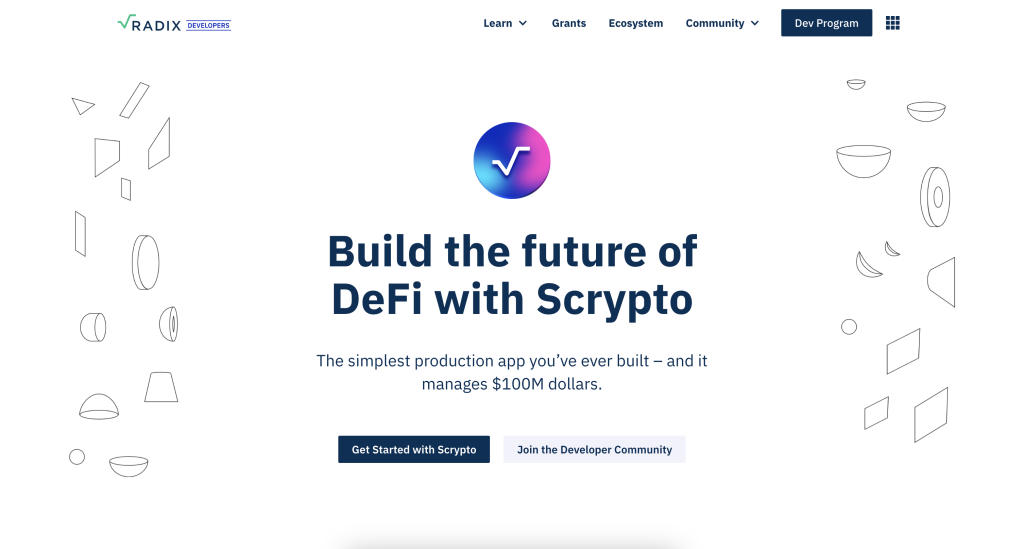The blockchain technology landscape continues to evolve, with projects focusing on various use cases. Radix stands out among these projects with a keen focus on DeFi (Decentralized Finance). This comprehensive review provides an in-depth look at Radix’s vision, uniqueness, journey, and future potential.
What is Radix?
Launched in 2020, Radix is a layer-1 protocol designed to serve as a foundation for DeFi applications. Built from the ground up, it addresses the major challenges hindering the widespread adoption of DeFi – scalability, security, and user experience.
Radix seeks to create a decentralized network where developers can easily build and deploy scalable DeFi applications.
Uniqueness of Radix
Radix differentiates itself from other blockchain projects with its unique technology stack designed explicitly for DeFi. The Radix Engine, a developer interface, allows developers to build and deploy complex DeFi applications with relative ease. It also ensures secure transaction execution by ensuring that all transactions are ‘atomic,’ meaning that they are either fully complete or don’t execute at all, minimizing the risk of failed transactions.
Moreover, Radix uses a unique consensus algorithm, Cerberus, to achieve high scalability while maintaining security. Cerberus allows Radix to process many transactions concurrently, making it suitable for high-demand DeFi applications.

The Radix Token (XRD) and Its Use Cases
The native currency of the Radix ecosystem is the Radix token (XRD). XRD incentivizes nodes to validate transactions and maintain the network’s integrity. It also plays a crucial role in Radix’s on-ledger governance mechanism, where token holders can vote on various proposals to guide the network’s development.
Furthermore, XRD is used as ‘fuel’ for executing transactions and smart contracts on the Radix network, mirroring the utility of ETH in the Ethereum ecosystem.
History of Radix
Radix was founded by Dan Hughes, a serial entrepreneur and technologist with a vision to solve the limitations of existing blockchain technologies, especially with respect to the burgeoning field of DeFi. Radix conducted a successful token sale in October 2020 and launched its mainnet, the Radix Public Network, in July 2021.
Since its inception, Radix has grown in leaps and bounds. The platform has drawn interest from numerous DeFi developers due to its unique technological offerings and promise of addressing the key challenges in the DeFi space.
Future Roadmap
Looking to the future, Radix’s roadmap features the pivotal “Xi’an” release slated for 2024. This upgrade promises to fully implement the sharded form of Radix’s unique Cerberus consensus protocol, an advancement that is central to the platform’s approach to scalability and security. The intricacies of the Cerberus consensus protocol are elaborated in the Cerberus Whitepaper and Cerberus Infographic Series.
Currently, potential implementations of sharded Cerberus are being tested and demonstrated on the Cassandra test network, with live demonstrations available on Twitch. The full deployment of the sharded Cerberus with the Xi’an release is set to position Radix as a leader in the realm of DeFi scalability.
Xi’an is designed to provide Radix with infinite linear scalability and unlimited atomic composability. These two features, both unique to Radix, are crucial to meeting the scalability demands of a global DeFi ecosystem poised to serve billions of people.
Beyond Xi’an, Radix plans to continue refining its technology and expand its user base. The team is focused on simplifying user onboarding for DeFi applications, improving network governance, and working towards seamless interoperability with other blockchain networks, such as Ethereum. This comprehensive approach to development emphasizes Radix’s commitment to shaping the future of the DeFi ecosystem.
Assessing Radix’s Future Potential
Radix’s vision of becoming the go-to platform for DeFi applications holds significant promise. Its unique approach to solving scalability, security, and user experience issues prevalent in existing DeFi infrastructure positions it as a potential game-changer.
However, Radix faces stiff competition, not only from established platforms like Ethereum but also emerging platforms that are equally focused on optimizing DeFi applications. Additionally, regulatory uncertainty surrounding DeFi could pose challenges.
Despite these challenges, Radix’s unique technology stack and focus on ease of use and high scalability indicate strong future potential. Its plans to simplify DeFi onboarding and foster interoperability with Ethereum further highlight its commitment to expanding the DeFi ecosystem.
To sum up, Radix’s vision, technology, and roadmap make it a compelling project in the rapidly evolving DeFi space. As Radix continues to build and refine its platform, it holds the promise to significantly impact how DeFi applications are developed and used, potentially shaping the future of the DeFi landscape.